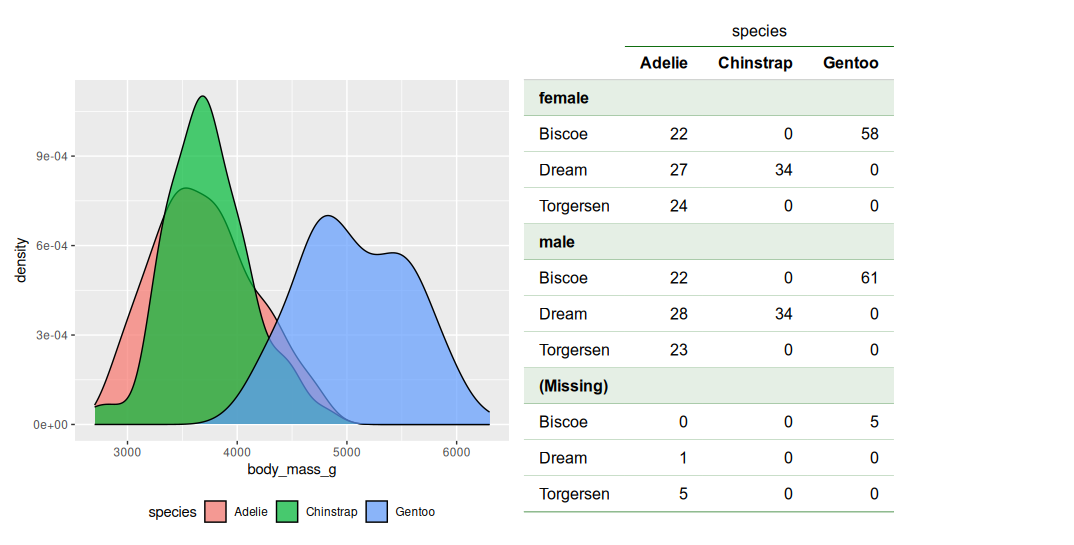
Quick and pretty frequency tables with ivo_table_gt
Source:vignettes/ivo_table_gt.Rmd
ivo_table_gt.RmdBackground
R has some great packages for creating nice-looking tables. Packages
like gt and flextable allow the user to create
a wide range of tables, with lots of flexibility in how these are
presented and formatted. The downside to these Swiss army knife-style
packages is that simple tasks, like creating a frequency table, require
a lot of typing. Enter ivo.table, a package for creating
great-looking frequency tables and contingency tables without any
hassle.
The package offers two functions for creating tables:
ivo_table, which uses the flextable framework,
and ivo_table_gt which uses the gt framework.
This vignette contains examples using the latter.
A first example
Let’s look at some examples using the penguins data from
the palmerpenguins
package. Say that we want to create a contingency table showing the
counts of the categorical variables species,
sex, and island. We can use
ftable along with dplyr’s
select:
library(dplyr)
#>
#> Attaching package: 'dplyr'
#> The following objects are masked from 'package:stats':
#>
#> filter, lag
#> The following objects are masked from 'package:base':
#>
#> intersect, setdiff, setequal, union
library(palmerpenguins)
#>
#> Attaching package: 'palmerpenguins'
#> The following objects are masked from 'package:datasets':
#>
#> penguins, penguins_raw
penguins |> select(species, sex, island) |> ftable()
#> island Biscoe Dream Torgersen
#> species sex
#> Adelie female 22 27 24
#> male 22 28 23
#> Chinstrap female 0 34 0
#> male 0 34 0
#> Gentoo female 58 0 0
#> male 61 0 0While informative, the formatting isn’t great, and it’s not something that we can easily export to a report or presentation.
ivo.table uses the same syntax, but with
ivo_table_gt instead of ftable:
library(ivo.table)
penguins |> select(species, sex, island) |> ivo_table_gt()|
species
|
|||
|---|---|---|---|
| Adelie | Chinstrap | Gentoo | |
| female | |||
| Biscoe | 22 | 0 | 58 |
| Dream | 27 | 34 | 0 |
| Torgersen | 24 | 0 | 0 |
| male | |||
| Biscoe | 22 | 0 | 61 |
| Dream | 28 | 34 | 0 |
| Torgersen | 23 | 0 | 0 |
| (Missing) | |||
| Biscoe | 0 | 0 | 5 |
| Dream | 1 | 0 | 0 |
| Torgersen | 5 | 0 | 0 |
You can add row and column sums:
penguins |>
select(species, sex, island) |>
ivo_table_gt(sums = c("cols", "rows"))|
species
|
Total | |||
|---|---|---|---|---|
| Adelie | Chinstrap | Gentoo | ||
| female | ||||
| Biscoe | 22 | 0 | 58 | 80 |
| Dream | 27 | 34 | 0 | 61 |
| Torgersen | 24 | 0 | 0 | 24 |
| Total | 73 | 34 | 58 | 165 |
| male | ||||
| Biscoe | 22 | 0 | 61 | 83 |
| Dream | 28 | 34 | 0 | 62 |
| Torgersen | 23 | 0 | 0 | 23 |
| Total | 73 | 34 | 61 | 168 |
| (Missing) | ||||
| Biscoe | 0 | 0 | 5 | 5 |
| Dream | 1 | 0 | 0 | 1 |
| Torgersen | 5 | 0 | 0 | 5 |
| Total | 6 | 0 | 5 | 11 |
Changing the appearance of your tables
You can customise the look of your ivo_table_gt table
using styling arguments and gt functions. You can change
the colours and fonts used, highlight columns, rows or cells, make
columns bold, and more. Let’s look at some examples.
Change the font to Courier, use red instead of green, and make the
names in the sex column bold:
library(gt)
penguins |>
select(species, sex, island) |>
ivo_table_gt(color = "red",
font_name = "Courier") |>
tab_style(style = list(cell_text(weight = "bold")),
locations = cells_stub())|
species
|
|||
|---|---|---|---|
| Adelie | Chinstrap | Gentoo | |
| female | |||
| Biscoe | 22 | 0 | 58 |
| Dream | 27 | 34 | 0 |
| Torgersen | 24 | 0 | 0 |
| male | |||
| Biscoe | 22 | 0 | 61 |
| Dream | 28 | 34 | 0 |
| Torgersen | 23 | 0 | 0 |
| (Missing) | |||
| Biscoe | 0 | 0 | 5 |
| Dream | 1 | 0 | 0 |
| Torgersen | 5 | 0 | 0 |
Add a caption and highlight the cell on the fourth row of the third column:
penguins |>
select(species, sex, island) |>
ivo_table_gt(caption = "A table with penguins in it") |>
tab_style(style = list(cell_fill(color = "darkgreen")),
locations = cells_body(columns = 5, rows = 4))| A table with penguins in it | |||
|
species
|
|||
|---|---|---|---|
| Adelie | Chinstrap | Gentoo | |
| female | |||
| Biscoe | 22 | 0 | 58 |
| Dream | 27 | 34 | 0 |
| Torgersen | 24 | 0 | 0 |
| male | |||
| Biscoe | 22 | 0 | 61 |
| Dream | 28 | 34 | 0 |
| Torgersen | 23 | 0 | 0 |
| (Missing) | |||
| Biscoe | 0 | 0 | 5 |
| Dream | 1 | 0 | 0 |
| Torgersen | 5 | 0 | 0 |
ivo_table_gt returns a gt object, meaning
that all functions used to style gt tables can be used. You can also
paste ggplot2 plots and tables together using
patchwork:
library(ggplot2)
library(patchwork)
penguins_plot <- ggplot(penguins, aes(body_mass_g, fill = species)) +
geom_density(alpha = 0.7) +
theme(legend.position = "bottom")
penguins_table <- penguins |>
select(species, sex, island) |>
ivo_table_gt()
penguins_plot + penguins_table